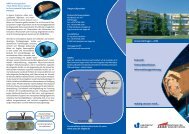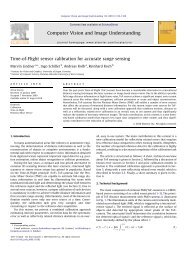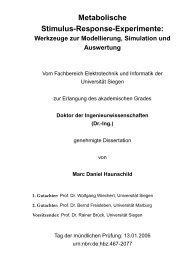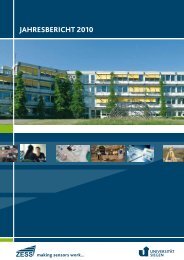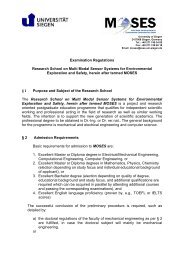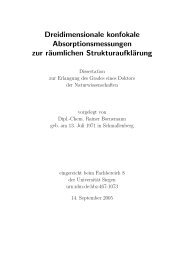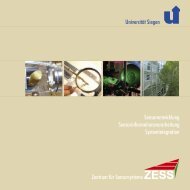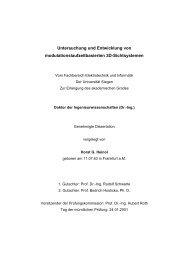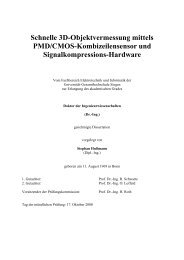Nomenklatur - im ZESS
Nomenklatur - im ZESS
Nomenklatur - im ZESS
Erfolgreiche ePaper selbst erstellen
Machen Sie aus Ihren PDF Publikationen ein blätterbares Flipbook mit unserer einzigartigen Google optimierten e-Paper Software.
Abstract<br />
Filter with a non-linear state space model there are Kalman-Filter algorithms that can determine<br />
states and parameters while the system model remains linear. These algorithms have been<br />
examined, extended and adapted to this particular problem. Comparing the different linear<br />
adaptive algorithms with the non-linear Extended Kalman-Filter, the Max<strong>im</strong>um-Likelihood<br />
based adaptive Kalman-Filter has proven to be the most suitable method for this problem. Basic<br />
knowledge of the probability density function of the unknown parameters is not necessary<br />
and the unknown parameters can be found in the complete state space model. The fact of<br />
provable stability represents a significant aspect for a commercial use of this algorithm.<br />
When the est<strong>im</strong>ation of the air mass in the cylinder is performed by a combustion pressure signal<br />
there is a necessity to el<strong>im</strong>inate the disturbances in the pressure signal. Therefore, a linear<br />
Kalman-Filter for the determination of the absolute cylinder pressure value has been developed.<br />
The algorithm is able to filter the combustion pressure signal during runt<strong>im</strong>e and to determine<br />
the variable offset provoked by the thermal shock. This procedure has been tested with an uncooled<br />
combustion pressure sensor and compared to a watercooled one. In the vehicle, the<br />
filter oscillates from working cycle to working cycle to any offset and follows a distinct drift<br />
created by a change of the working conditions.<br />
Through a sensitivity analysis of the parameters of the physically based model, the temperature<br />
of the A/F mixture has been identified as the parameter which influences mainly the est<strong>im</strong>ation<br />
result and is difficult to determine. As a result, an adaptive Kalman-Filter algorithm has been<br />
derived that est<strong>im</strong>ates the cylinder individual air mass from measured cylinder pressure and<br />
adapts the temperature of the A/F mixture through the lambda-sensor signal. The effect of the<br />
t<strong>im</strong>e delay of the cylinder pressure information compared to conventional sensors is taken into<br />
account by a prediction algorithm that determines the changes of the air mass during transient<br />
conditions using throttle angle gradients.<br />
The algorithm has been tested with measured vehicle data, <strong>im</strong>plemented in a prototype engine<br />
control unit with the following results. The deviation in the lambda-sensor signal is in the size<br />
of the mass electronic control unit and even better. This has been achieved with a pure model<br />
based algorithm without calibration on the testbed or in the vehicle.<br />
The advantage of the est<strong>im</strong>ation of the air mass on the basis of measured cylinder pressure<br />
signals can be seen in the cylinder individual determination of the air mass, the exclusion of<br />
conventional faults like air leakage and throttle faults, the high redundancy for reliability and<br />
diagnostic concepts and by rendering the determination of the volumetric efficiency superfluous.<br />
In addition, there are enormous possibilities for the realisation of cylinder individual engine<br />
functions such as knock and spark angle control.<br />
IX



